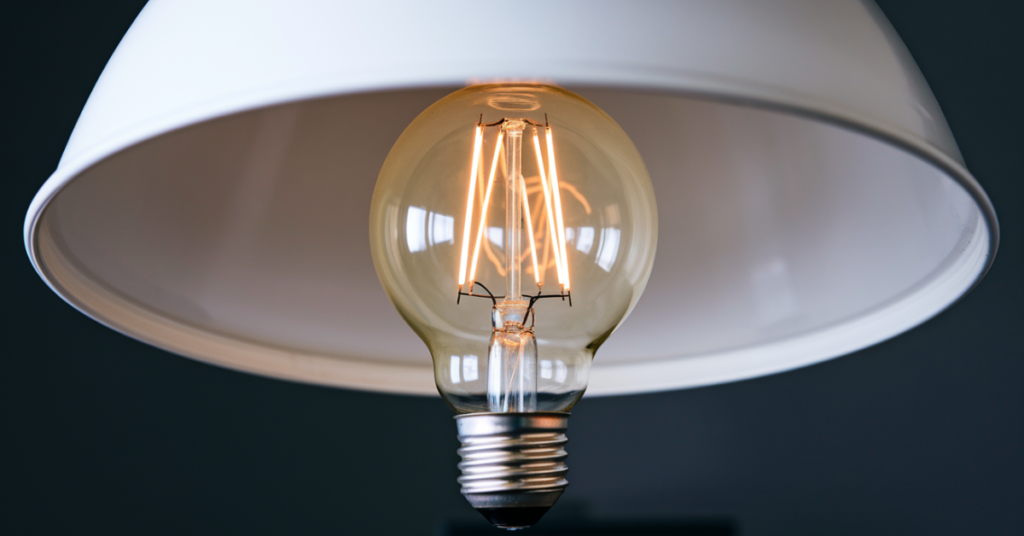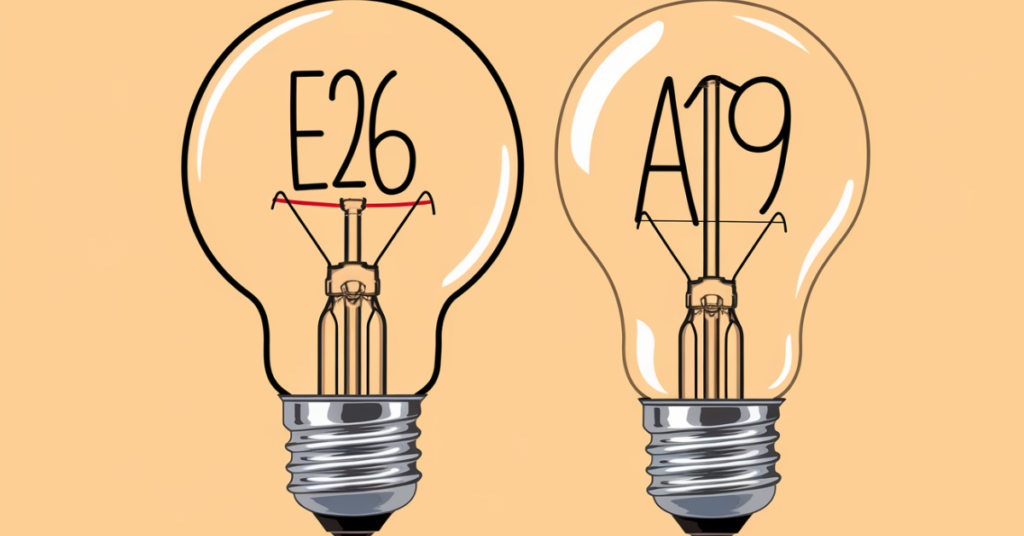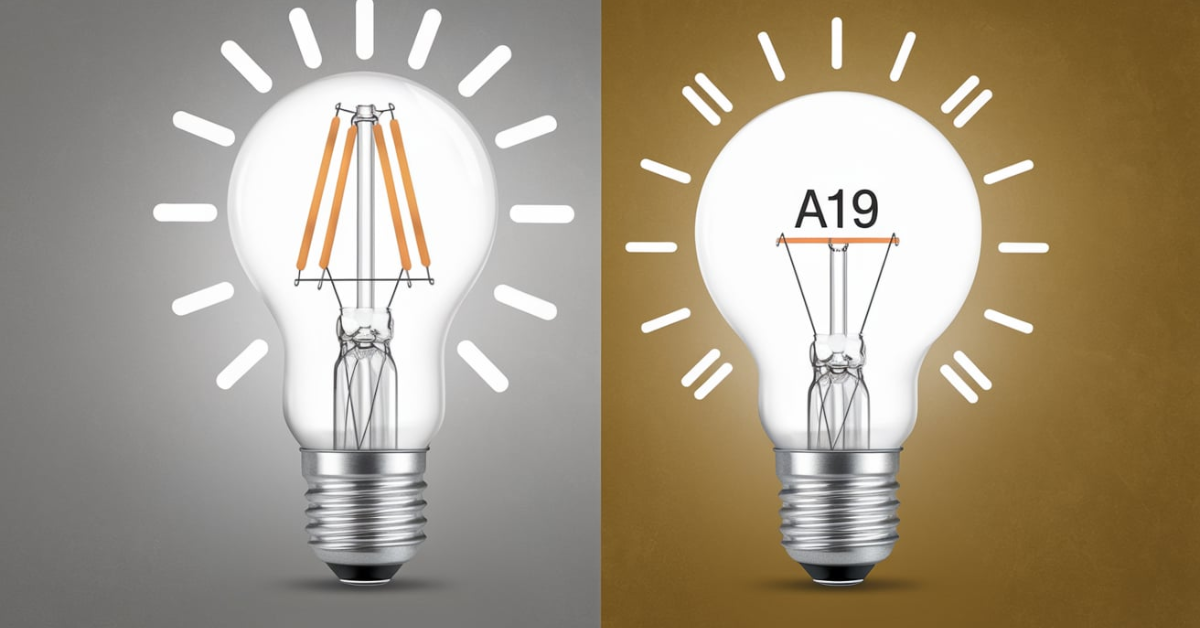In the world of lighting, understanding the terminology can sometimes be confusing.Two terms that often come up in discussions about light bulbs are E26 and A19.
Many people wonder if these terms are interchangeable or if they refer to different aspects of a light bulb.
This article aims to shed light on this topic and provide clarity on the differences and similarities between E26 and A19.
What Is An E26 Base?

The term E26 refers to a specific type of light bulb base which is the part of the bulb that screws into a light socket.Let’s break down what E26 actually means:
Read This Blog:What Is Application In Zillexit Software?:A Detailed Analysis
E For Edison
The ‘E’ in E26 stands for Edison named after the famous inventor Thomas Edison who pioneered the development of the electric light bulb.
This designation is used for screw-type bases which are the most common type found in residential lighting in North America.
26 For Diameter
The number ’26’ indicates the diameter of the base in millimeters.Thus, an E26 base has a diameter of 26 millimeters at its widest point.
E26 bases are widely used in North America for a variety of light bulb types including incandescent CFL (Compact Fluorescent Lamp) and LED (Light Emitting Diode) bulbs.
This standardization allows for easy replacement and compatibility across different lighting fixtures.
What Is An A19 Bulb?

While E26 refers to the base of a light bulb, A19 describes the shape and size of the bulb itself. Let’s examine what A19 means:
Read This Blog:Project Omega?Unpacking Elon Musk’s Mystery Project
A For Arbitrary
The ‘A’ in A19 stands for “Arbitrary,” which might seem strange at first.However, it simply refers to the standard pear-shaped bulb that most people picture when they think of a light bulb.
This shape has become so common that it’s considered the “arbitrary” or standard shape for light bulbs.
19 For Diameter
Similar to E26, the ’19’ in A19 indicates a measurement.In this case, it refers to the diameter of the bulb at its widest point measured in eighths of an inch.So, an A19 bulb has a diameter of 19/8 inches, or about 2.375 inches.
A19 bulbs are the most common shape for general-purpose lighting in homes and offices.They provide omnidirectional light meaning they emit light in all directions, making them suitable for a wide range of applications.
Are E26 And A19 The Same?

Now that we’ve defined both E26 and A19 we can address the main question:are they the same thing? The short answer is no, but they are often used together.
E26 refers to the base of the bulb while A19 describes the shape and size of the bulb itself.
Many A19 bulbs have an E26 base, which is why these terms are often seen together.However, it’s important to understand that:
- Not all E26 base bulbs are A19 shaped
- Not all A19 shaped bulbs have an E26 base
For example you can find E26 bases on bulbs of different shapes, such as globe (G) or candle (C) shapes.Similarly, in some countries, A19 shaped bulbs might have a different base type, such as E27 (common in Europe).
Advantages Of Using E26 And A19 Bulbs
There are several benefits to using bulbs with E26 bases and A19 shapes:
- Wide Availability:Due to their popularity, these bulbs are readily available in most hardware stores and online retailers.
- Compatibility:E26 bases fit most standard light fixtures in North America, making them highly versatile.
- Variety of Options:Both E26 base and A19 shape are available in various types of bulbs, including incandescent, CFL, and LED, offering choices for different lighting needs and preferences.
- Energy Efficiency:Many modern A19 LED bulbs with E26 bases are highly energy-efficient, helping to reduce electricity costs.
- Familiarity:The A19 shape is what most people associate with a “standard” light bulb, making it easy to choose and replace.
E26 Vs A19
While E26 and A19 are often used together, it’s useful to understand how they differ:
E26
- Refers to the base of the bulb
- Indicates a screw-type base
- 26mm in diameter
- Can be found on various bulb shapes
A19
- Describes the shape and size of the bulb
- Refers to the classic pear shape
- 19/8 inches (about 2.375 inches) in diameter at its widest point
- Can have different types of bases
Understanding these differences can help you make more informed decisions when purchasing light bulbs and ensure compatibility with your existing fixtures.
How To Choose The Right Bulb For Your Needs

Selecting the appropriate light bulb involves more than just knowing about E26 bases and A19 shapes.Here are some factors to consider:
- Fixture Compatibility:Ensure the base type (e.g., E26) matches your light fixture.
- Light Output:Consider the lumens (brightness) you need for the space.
- Color Temperature:Choose between warm (yellowish) and cool (bluish) light tones.
- Energy Efficiency:Look for ENERGY STAR certified bulbs for better efficiency.
- Dimming Capabilities:If you have a dimmer switch, ensure your chosen bulb is dimmable.
- Lifespan:LED bulbs typically last longer than incandescent or CFL bulbs.
- Special Features:Some bulbs offer additional features like color changing or smart home compatibility.
By considering these factors alongside the base and shape specifications, you can find the perfect bulb for your lighting needs.
Read This Blog:How To Get Tech Points In Palworld
Common Mistakes When Choosing Light Bulbs
To help you avoid common pitfalls, here are some mistakes people often make when selecting light bulbs:
- Focusing only on wattage:While wattage is important for power consumption, lumens are a better indicator of brightness.
- Ignoring color temperature:Choosing the wrong color temperature can significantly affect the ambiance of a room.
- Overlooking dimming compatibility:Not all LED bulbs are dimmable, and using non-dimmable bulbs with dimmer switches can cause flickering or damage.
- Neglecting to check the base type:Assuming all bulbs have the same base can lead to purchasing incompatible bulbs.
- Forgetting about size constraints:Some fixtures may have limited space, making certain bulb shapes unsuitable.
By being aware of these common mistakes, you can make more informed decisions when purchasing light bulbs.
Tips For Replacing E26 And A19 Bulbs
When it’s time to replace your light bulbs, keep these tips in mind:
- Turn off the power:Always ensure the light switch is off before changing a bulb.
- Allow the bulb to cool:If the bulb has been in use, give it time to cool down before handling.
- Use a ladder or step stool:Ensure you can safely reach the bulb without stretching or straining.
- Handle with care:Hold the bulb by its base, not the glass part, to avoid damage.
- Don’t overtighten:Screw the new bulb in firmly, but avoid overtightening, which can make future removal difficult.
- Dispose of old bulbs properly:Check local regulations for proper disposal, especially for CFL bulbs which contain small amounts of mercury.
- Keep track of specifications:Note the details of the bulb you’re replacing to make future purchases easier.
Following these tips can help ensure safe and effective bulb replacement.
The Future Of Light Bulb Technology
As technology continues to advance, the lighting industry is evolving. While E26 bases and A19 shapes remain popular, new innovations are emerging:
- Smart Bulbs:These Wi-Fi or Bluetooth-enabled bulbs can be controlled via smartphone apps or voice assistants.
- Color-Changing LEDs:Bulbs that can change color to suit different moods or activities are becoming more common.
- Improved Energy Efficiency:LED technology continues to improve, offering even greater energy savings.
- Longer Lifespans:Some LED bulbs now boast lifespans of 20 years or more under normal usage.
- Alternative Shapes:While A19 remains popular, new shapes are being developed for specific applications or aesthetic preferences.
- Integration with Home Automation:Light bulbs are increasingly becoming part of larger smart home ecosystems.
- Human-Centric Lighting:Bulbs that can adjust their color temperature throughout the day to support natural circadian rhythms are gaining popularity.
As these technologies develop, we may see changes in standard base types and bulb shapes, but for now, E26 and A19 remain dominant in the North American market.
Frequently Asked Questions
What Does E26 Stand For?
E26 stands for Edison 26mm referring to a screw-type base with a diameter of 26 millimeters.
What Does A19 Mean?
A19 describes a standard, pear-shaped light bulb with a diameter of 19/8 inches (about 2.375 inches) at its widest point.
Can An E26 Base Fit An A19 Bulb?
Yes, many A19 bulbs have an E26 base, making them compatible with standard North American light fixtures.
Are E26 And A19 Bulbs Interchangeable?
Not necessarily. While many A19 bulbs have E26 bases not all E26 base bulbs are A19 shaped, and not all A19 shaped bulbs have E26 bases.
What Should I Consider When Buying E26 Or A19 Bulbs?
Consider factors like light output (lumens), color temperature, energy efficiency, dimming capabilities, and compatibility with your existing fixtures.
Conclusion
E26 and A19 are not the same thing.E26 refers to the bulb’s base type, while A19 describes its shape and size.However, they often go together in standard light bulbs, which is why the terms are frequently associated with each other.

William is a passionate fashion enthusiast with a keen eye for style trends.
With a background in textile design and years of experience in the Tech industry, William brings a unique perspective to his writing. He loves exploring sustainable fashion and street style.








